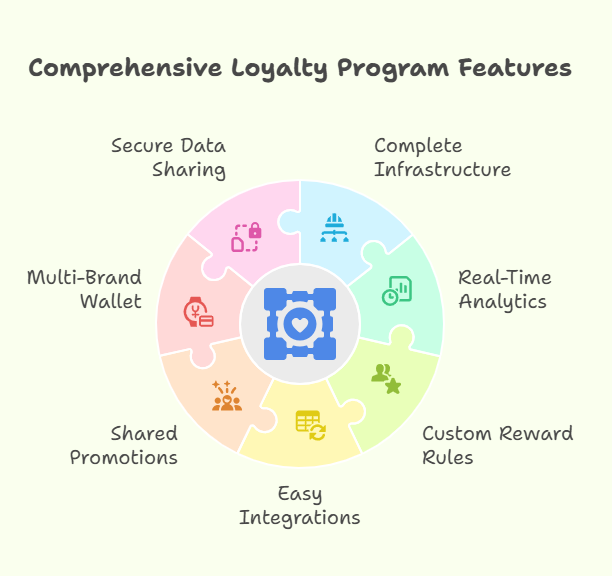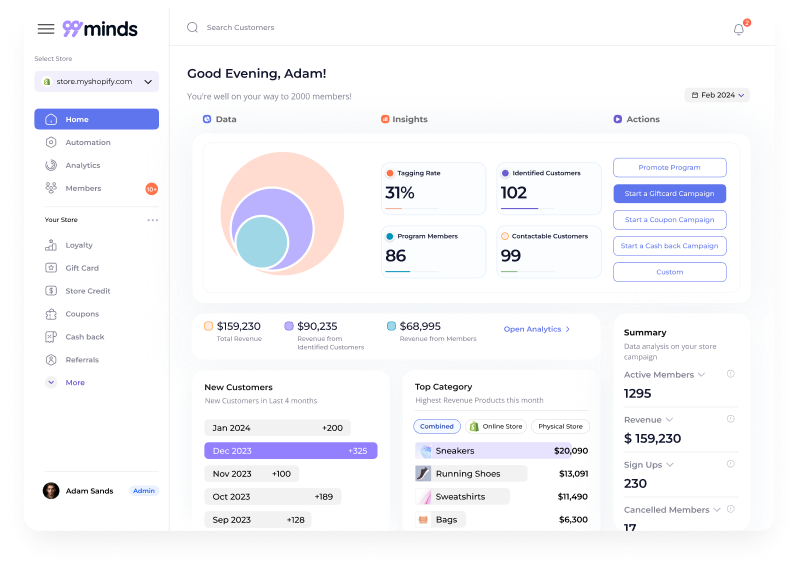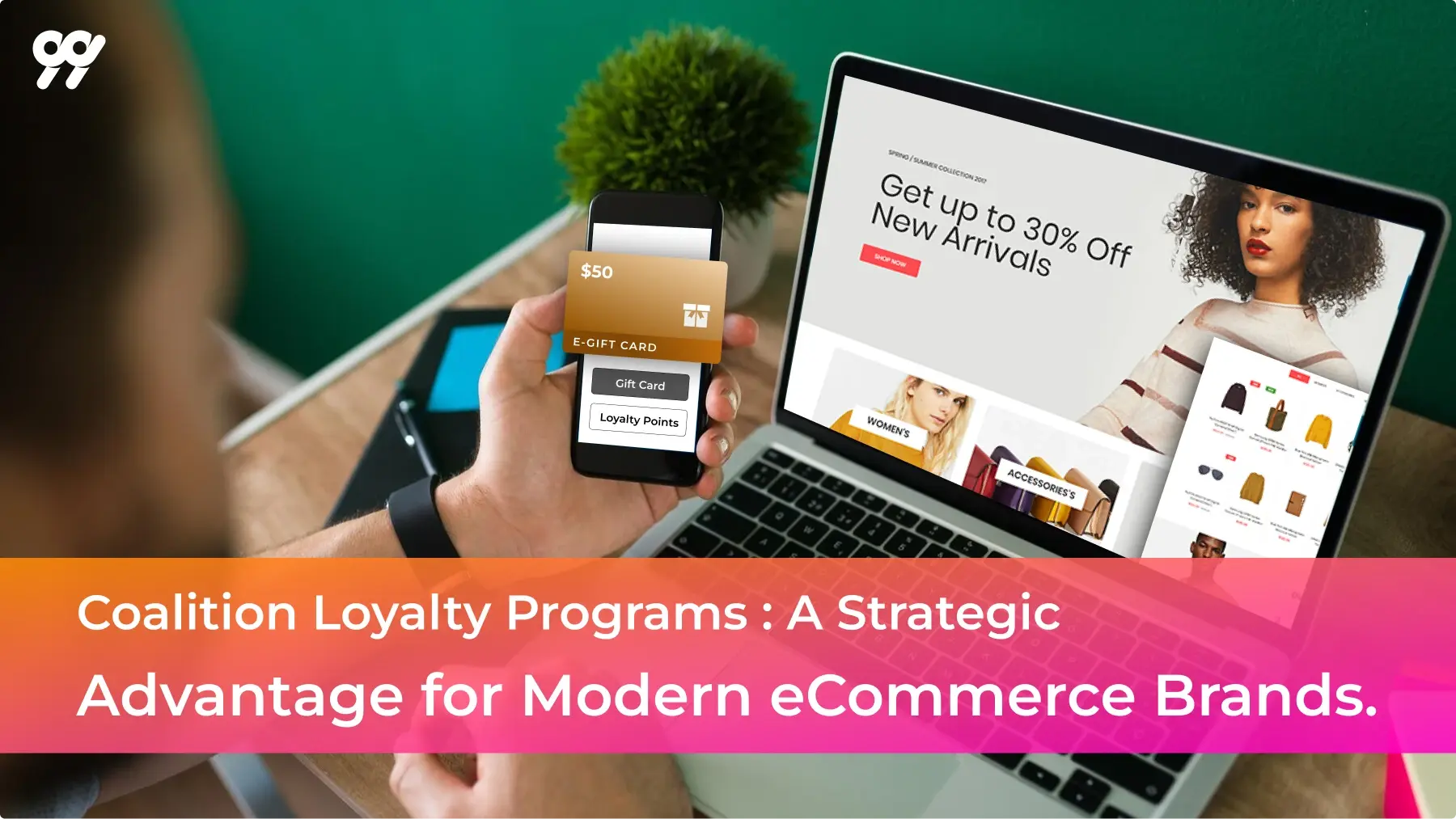
In today’s fast-changing retail world, dependability isn’t close to focuses or discounts—it’s around conveying genuine, progressing esteem. That’s precisely what consolidation devotion programs are planned to do.
Instead of one brand offering rewards on its own, coalition programs bring together multiple non-competing brands to create a shared loyalty ecosystem. Customers can earn points with one brand and redeem them with another—offering more choice, flexibility, and value.
As customer acquisition gets more expensive and retention becomes the focus, eCommerce brands are turning to partnerships to boost engagement, extend reach, and drive long-term loyalty.
This blog will walk you through what coalition loyalty programs are, how they work, and how your brand can benefit by being part of one.
What is a Coalition Loyalty Program?
To create a shared rewards ecosystem. Instead of offering points or benefits that can only be used within one brand, customers can earn and redeem points across a wide network of participating businesses—all under one unified program. Think of it as a team effort.
Let’s say your eCommerce store sells clothing. Under a coalition loyalty program, a customer might earn points when they shop from your store, but they can then use those points to get a discount on a cab ride, enjoy free coffee at a partner café, or book movie tickets on a partnered app—all within the same rewards system. That’s real, everyday utility, and that’s what makes it powerful.
How it works at a glance:
- Multiple brands (from different industries) participate in one common loyalty platform.
- Customers earn loyalty points when they shop at any of the participating brands.
- Those points can be redeemed across the entire partner network, giving customers more flexibility and motivation to keep coming back.
It’s like a loyalty wallet in your pocket
Whether through a mobile app or a unified web interface, users can track their points, rewards, and partner deals in one place. No need to juggle five different loyalty cards or logins—just one streamlined system.
This model boosts customer satisfaction and brand visibility, while also encouraging users to shop more frequently within the partner ecosystem. It’s not just about retaining customers—it’s about creating shared value through collaboration.
Key Components of a Coalition Loyalty Program
A fruitful fusion dependability program isn’t around putting a couple of brands together—it requires a well-thought-out system and consistent execution. Here’s what makes it tick:
- Lead Brand or Devotion Stage
This can be the grapple of the program—usually a major brand, retail chain, or a devotion innovation supplier like 99minds or Payback. They set the rules, oversee the framework, and manage the operations of the complete consolidation.
- Accomplice Brands
These are the partaking dealers over different categories—retail, travel, feasting, mold, basic need, excitement, etc. They contribute to the esteem biological system by permitting clients to gain or recover focuses through their stages.
- All inclusive Focuses Cash
A shared or standardized focuses framework permits clients construct up">to construct up focuses from one brand and utilize them over the organize. This bound together rewards cash is what makes amalgamation devotion feel consistent and profitable.
- Client Profiles
Consolidation programs utilize centralized and bound together client profiles, built on secure, consent-based information sharing. This empowers brands to get it behavior over the arrange and personalize rewards accordingly—without compromising on security or compliance.
- Tech Stack & Integration Tools
Behind the scenes, the program runs on robust technology:
- APIs for real-time data syncing.
- CRM & CDP systems for customer data management.
- Loyalty platforms like 99minds, Annex Cloud, or Antavo for rewards orchestration.
- POS integrations to track purchases at the retail level.
- Mobile apps or wallets to give customers access to their points, transaction history, and offers in one place.
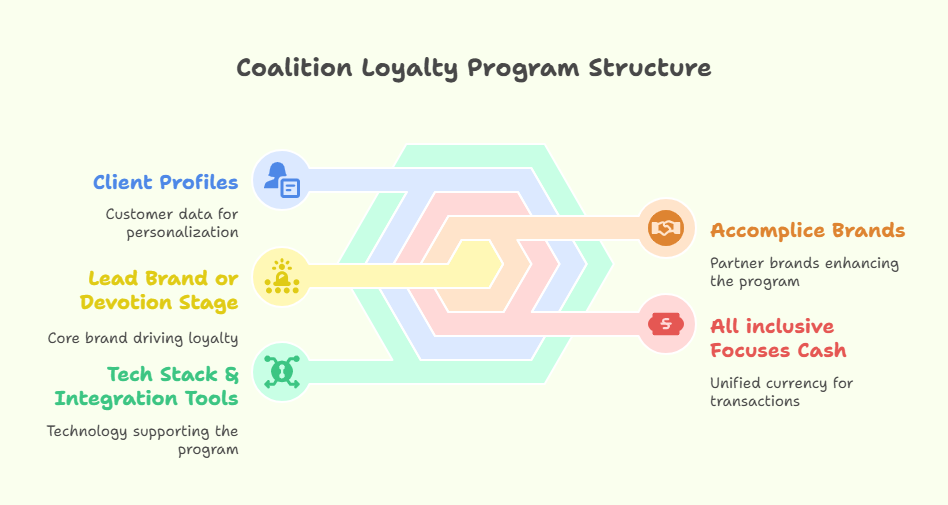
- Rewards Catalog
A dynamic and diverse rewards marketplace that offers vouchers, discounts, cashbacks, gifts, and exclusive deals across partner brands. The wider and more personalized the catalog, the more engaging the program becomes.
- Rules & Redemption Logic
Every coalition needs clear guidelines:
- How are points calculated?
- When do they expire?
- Can they be transferred or gifted?
- What qualifies as a redemption-worthy purchase?
These rules must be easy to understand for customers and consistent across all partners.
- Performance & Reporting Dashboard
Brands need access to real-time dashboards and analytics to track how the program is performing—user engagement, points issued/redeemed, partner contributions, and ROI metrics.
- Data Privacy & Compliance Layer
A critical but often overlooked piece. Since customer data is shared across brands, the coalition must ensure GDPR, CCPA, and local data privacy law compliance. Consent management, encryption, and secure storage must be built in from day one.
- Customer Support System
Because the loyalty program spans multiple brands, a unified customer support mechanism is essential—either managed by the lead brand or through a dedicated loyalty support team.
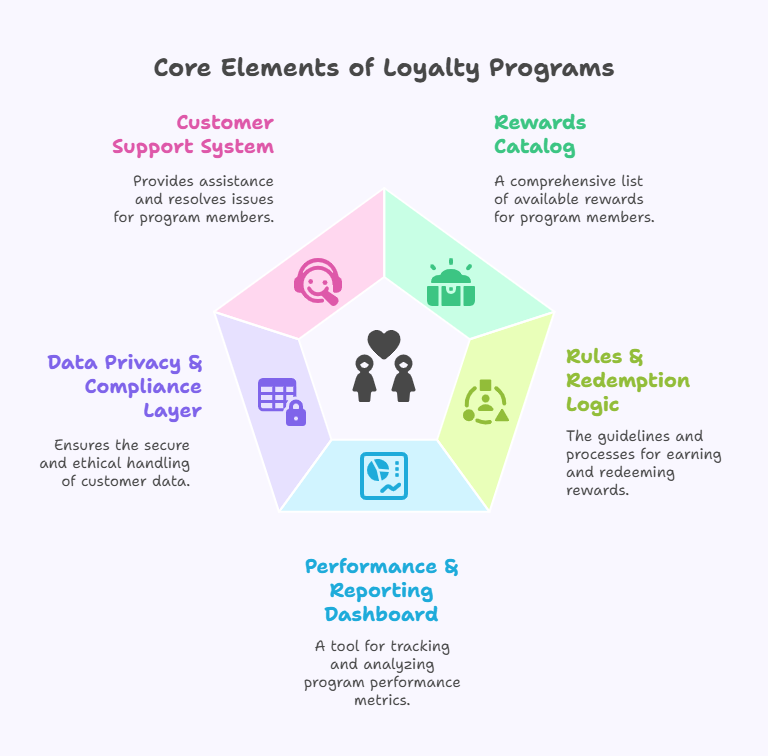
Benefits of Coalition Loyalty Programs for eCommerce Merchants
Fusion dependability programs offer more than fair a new turn on client retention—they open a vital environment where shippers can develop together by conveying more esteem, building more grounded connections, and progressing ROI. Here’s how partaking in a fusion dependability program benefits eCommerce brands:
- Enhanced Customer Value
When customers can earn and redeem points across a network of their favorite brands, the perceived value of every transaction increases. Instead of limiting rewards to your store, you're part of a bigger lifestyle loop.
For example, a customer buys skincare from your site, earns points, and then uses them to get a discount on groceries or fitness gear. This flexibility keeps customers engaged longer and shopping more often.
- Shared Marketing Power
One of the strongest advantages of coalition programs is co-marketing. When you partner with other non-competing brands, you gain exposure through joint campaigns, emails, social promotions, and loyalty communications. This means more reach, higher visibility, and stronger brand recall—without spending extra on ads. Everyone wins.
- Cross-Selling Opportunities
Coalition loyalty opens the door to new audiences. Your brand is now visible to customers of other participating brands—people who may not have discovered you otherwise. This kind of cross-pollination gives you a shot at introducing your products to an aligned yet untapped segment.
- Data Pooling for Better Insights
Coalition partners often share anonymized data to help each other understand broader customer behavior. This lets you see how your customers interact with other categories, when they shop, what they value, and even where they drop off. These insights enable you to craft hyper-personalized campaigns, optimize inventory, and tweak pricing strategies—all based on real behavior, not assumptions.
- Reduced Customer Acquisition Costs (CAC)
By participating in a coalition, your brand is automatically introduced to other brands’ loyal customers—without having to pay high acquisition costs through paid ads. It’s word-of-mouth and trust by association. Your CAC decreases because customers already trust brands within the coalition—they’re more likely to explore and try your offerings.
- Improved Customer Retention & Lifetime Value
With more frequent earning and redemption options across a variety of brands, customers are more likely to stay active within the ecosystem. This means fewer lapsed users and higher customer lifetime value (CLTV). You don’t just get a sale—you get a loyalist who keeps coming back.
- Diversified Reward Options
Running a solo loyalty program limits the type of rewards you can offer. But in a coalition, you can give your customers access to a wider rewards catalog—vouchers, discounts, services, and more. You don’t bear the full burden of offering rewards, yet your customers benefit, making the program more appealing without extra operational load.
- Stronger Partner Relationships
Working within a coalition naturally fosters business collaboration. Brands often find opportunities for joint campaigns, seasonal bundles, affiliate partnerships, or co-created offers that go beyond loyalty. It’s a network effect that keeps getting stronger over time.
- Scalability Without Complexity
With the right loyalty tech stack (like 99minds), your brand can plug into an existing coalition program without having to build everything from scratch. This lowers operational effort and lets you scale faster with minimal tech overhead. The platform handles the hard part—you focus on the rewards strategy.
- Competitive Differentiation
In crowded markets, brands need a unique angle to stand out. Being part of a trusted coalition loyalty network can be a key differentiator.It signals innovation, customer-centricity, and strategic vision—helping you stand out in the eyes of customers, partners, and even investors.
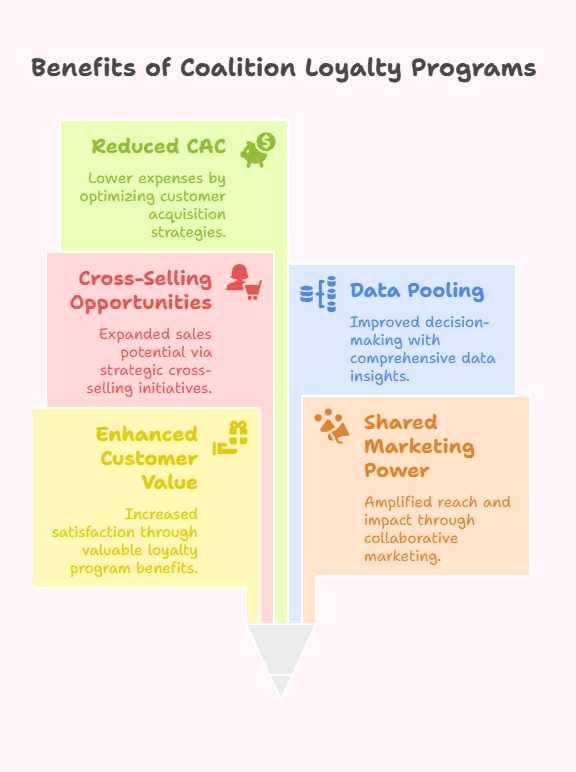
Types of Coalition Loyalty Models
The merger program is not big. Depending on the methodology, industry, and client base, brands can select from diverse fusion structures. Every demonstration has its mechanisms, benefits and challenges. Here’s a closer see:
- Open Coalition
This is the most flexible and widely recognized model.
- How it works: Multiple unrelated brands come together under one umbrella program. Any brand that meets certain requirements (like technical compatibility or customer relevance) can join.
- Examples: Payback India. Air Miles Canada.
- Best for: Large-scale loyalty ecosystems with a wide customer base across various industries (retail, fuel, travel, dining).
- Pros: Wide variety of partners, more earning/redemption options for customers, fast network growth.
- Cons: Less control over partner alignment or customer journey consistency.
- Closed Coalition
This is a more curated model, focused on strategic alignment between a select group of partners.
- How it works: A few handpicked, non-competing brands form a loyalty network, usually centered around a similar audience or lifestyle category.
- Examples: A fitness coalition featuring a sportswear brand, a health supplement company, and a gym chain.
- Best for: Brands seeking deeper collaboration with aligned customer values and better brand synergy.
- Pros: Higher trust between partners, targeted customer engagement, easier to manage.
- Cons: Smaller network, slower to scale.
- Industry-Specific Coalition
Here, all partners belong to the same industry or sector.
- How it works: Brands within a single niche (like fashion, automotive, or wellness) join forces to offer shared loyalty rewards.
- Examples: Multiple beauty brands collaborating under one premium loyalty card. Travel-based coalitions involving airlines, hotels, and car rental services.
- Best for: Brands in competitive industries looking to retain customers and build industry-wide loyalty.
- Pros: Deep brand alignment, more relevant rewards, better customer targeting.
- Cons: Risk of overlap or direct competition if not managed properly.
- Retailer-Led Coalition
A single large retailer acts as the anchor brand, inviting smaller or complementary brands to join.
- How it works: The lead retailer controls the loyalty structure while partners plug in for access to their ecosystem.
- Examples: A supermarket chain like Tesco building a coalition with fuel stations, pharmacies, and lifestyle brands.
- Best for: Large retail brands that want to expand customer reach through ecosystem building.
- Pros: Strong customer base from the anchor brand, easier onboarding for partners, higher transaction volumes.
- Cons: Power imbalance—smaller brands have less say in decisions or customer data access.
- Geographic or Regional Coalition
Brands within a specific region, city, or local area collaborate to boost footfall, visibility, and loyalty.
- How it works: Local businesses—cafes, fitness studios, boutiques, etc.—join forces to offer loyalty points across the neighborhood.
- Examples: A “shop local” coalition in a city that rewards residents for supporting local businesses.
- Best for: Small businesses aiming to retain local customers and compete with big chains.
- Pros: Builds community engagement, promotes local commerce, encourages repeat visits.
- Cons: Limited scalability, may require manual systems or simple tech setups if resources are constrained.
- Brand Alliance Loyalty (Lifestyle-Based)
Coalitions formed around a shared lifestyle or customer identity.
- How it works: Brands that appeal to the same target demographic—say, eco-conscious millennials—partner to provide relevant and value-based rewards.
- Examples: A green lifestyle coalition with sustainable fashion, plant-based food delivery, and eco-travel partners.
- Best for: Purpose-driven brands or niche audiences.
- Pros: Highly relevant to the user, stronger emotional connection, increased loyalty.
- Cons: Smaller niche, needs clear brand alignment and values.
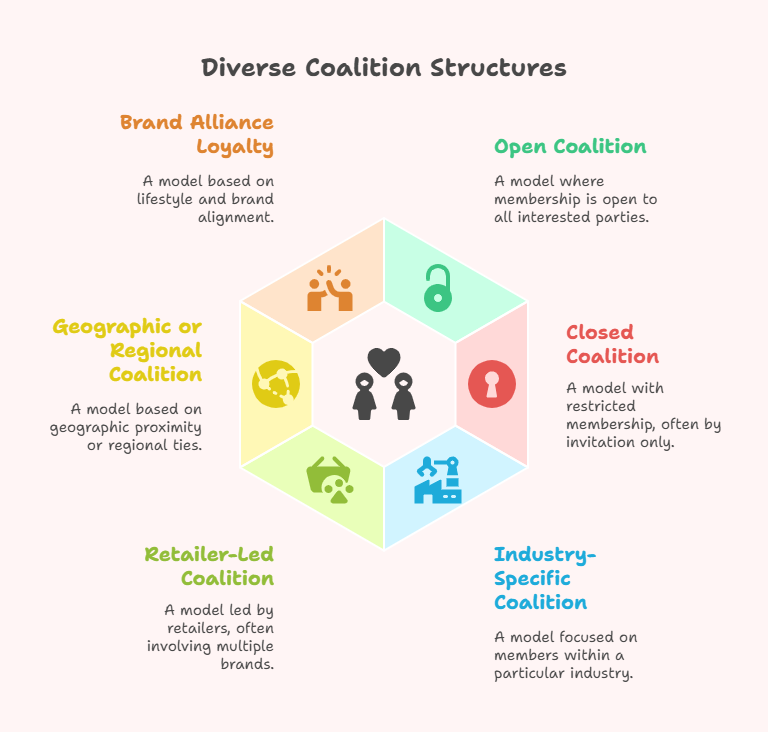
How to Build a Successful Coalition Loyalty Program?
Step 1: Define your strategic goals
What do you want to achieve? Acquisition, storage, or branded plaster?
Step 2: Choose the right partner
Choose additional offers and valuable brands.
Step 3: Design a uniform point system
Just do it. Transparent, universal point transformations accumulate.
Step 4: Create a seamless technical ecosystem
Integrate through platforms such as 99minds, which support API, CRMS, POS, and E-Commerce tools.
Step 5: Check
We will advance data protection laws (such as GDPR) and create clear, free gauges.
Step 6: Start with a bang
Marketing is important. Co-branded campaigns, email explosions and cross-channel promotions reduce awareness.
Step 7: Tracking and Optimizing
Monitor KPIs such as engagement rates, crossburn return solutions, and service life.
Challenges to Consider
A coalition-loving program offers many benefits, but you also have your own challenges. These programs include several stakeholders, data exchange and a consistent user experience. This is inevitably complicated. Let’s break down the most common hurdles you need to know:
- Revenue Sharing Agreements
What it means: Since multiple brands are involved, there needs to be a fair way to distribute the costs and revenue generated by the loyalty program. This includes who pays for the rewards, how points are valued across brands, and how each transaction is accounted for.
Why it’s tricky:
- Different brands have different margins and budgets.
- If one brand’s customers redeem rewards mostly at another brand, there could be financial imbalances.
- Negotiating and maintaining these agreements requires ongoing coordination, especially when new partners join or customer behavior shifts.
- Customer Data Ownership & Privacy
What it means: A core benefit of coalition programs is shared access to customer insights—but who actually owns that data? And how can it be shared in a way that’s ethical, legal, and privacy-compliant?
Why it’s tricky:
- Not all partners may be comfortable sharing their customer data.
- Privacy laws like GDPR, CCPA, and India’s DPDP Act require clear user consent and secure handling of data.
- If not handled properly, it can lead to data misuse, legal risks, and even customer distrust.
Pro Tip: Use a platform that supports consent-based data sharing and encrypts data for all parties involved.
- Operational Complexity
What it means: Running a coalition loyalty program is a lot more complex than a single-brand setup. You need to sync systems, manage transactions, track points in real-time, and ensure a consistent customer experience.
Why it’s tricky:
- Every partner may use different POS systems, CRMs, or inventory tools.
- Points calculation and redemption rules must stay consistent across the board.
- Tech integration needs to be smooth, or you risk system glitches, frustrated users, and angry partners.
Solution: Choosing a scalable loyalty platform like 99minds with strong API support helps reduce integration pain and maintain consistency.
- Brand Compatibility Issues
What it means: A coalition program only works if the participating brands complement each other and appeal to a similar target audience. A false partnership can undermine the appeal and reputation of the program.
Why it’s difficult:
If the brands are different, customers are not worth including rewards. If the brand is below average, this will affect the experience of the whole coalition. There may also be brand positioning - for example, luxury skintenders may not want to join a coalition with discount-contonience chains.
Modifications: Clear guidelines for careful partner selection, consistent branding, and network qualifications.
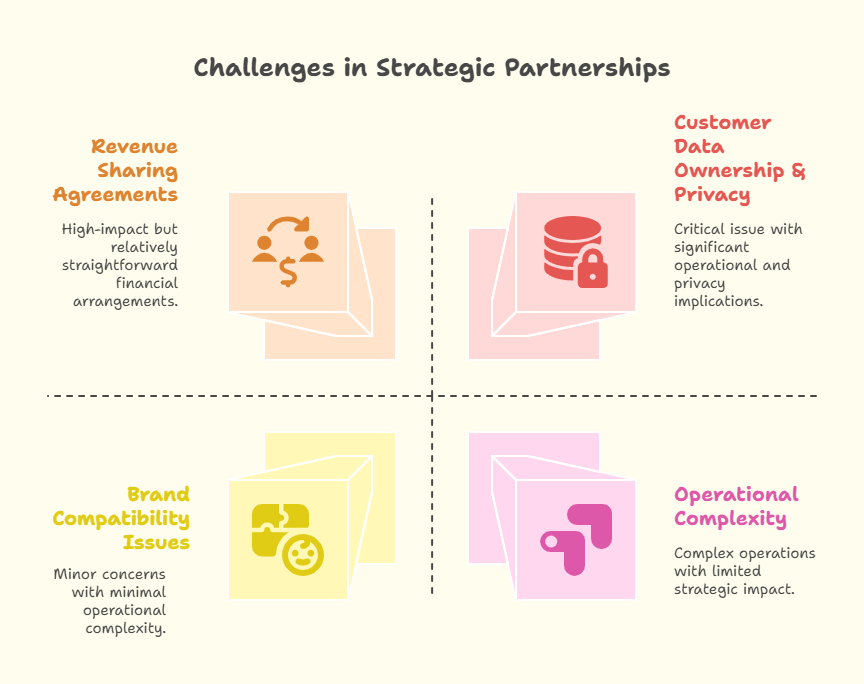
99minds and Coalition Loyalty Programs
Coalition loyalty programs may sound complex, but platforms like 99minds simplify everything. They help eCommerce brands and retail businesses build, manage, and scale coalition loyalty ecosystems without any technical headaches.
Here’s how 99minds enables smooth collaboration between partner brands:
- Complete Coalition Loyalty Infrastructure
99minds acts as the foundation for your coalition program. It gives you the tools to launch a multi-brand loyalty system with ease. Brands can create their own reward rules, plug into a central loyalty ecosystem, and go live in days—not months.
It supports:
- Multi-brand point tracking.
- Shared and brand-specific rewards.
- Customer management under one platform.
- Real-Time Cross-Brand Analytics
99minds allows you to monitor loyalty performance across the entire coalition in real-time. From point issuance and redemption to partner-specific engagement metrics, you get complete visibility into what’s working and
what’s not.
Track:
- Points flow between brands.
- Redemption hotspots.
- Campaign-specific results.
- Loyalty behavior across all touchpoints.
- Custom Reward Rules Per Brand
Each brand in a coalition can operate differently. 99minds allows you to create flexible reward rules tailored to your business—while still being part of the collective ecosystem.
You can customize:
- Earn and burn rates.
- Point expiry settings.
- Redemption conditions.
- Customer segments and tiers.
- Easy Integrations with Existing Systems
Already using Shopify, Woocommerce, Magento, or a custom platform? 99minds is integrated into your existing technology stack via APIs to ensure smooth data synchronization and a consistent loyalty experience. No reconfiguration or severe IT participation - plug and play only.
- Shared Promotions and Co-Branded Campaigns
99minds enables coalition partners to run joint marketing efforts. You can launch:
- Shared discount campaigns.
- Bundle offers between brands.
- Seasonal or event-based promotions.
- Cross-brand reward incentives.
- This brings more visibility, deeper engagement, and mutual value for each brand involved.
- Multi-Brand Customer Wallet
With a unified reward wallet, customers can earn and redeem points across all partner brands—without confusion or friction.
Customers enjoy:
- One place to view their rewards.
- Seamless redemption across brands.
- A consistent loyalty experience from store to store.
- Secure and Compliant Data Sharing
Coalition loyalty programs involve data sharing—99minds makes sure that happens securely and within legal boundaries. It’s built with strong compliance and security features.
Includes:
- Consent-based data sharing.
- GDPR and CCPA readiness.
- Data encryption and access control.
- Transparent audit logs for accountability.
- Why Choose 99minds for Coalition Loyalty
- Launch faster with pre-built loyalty modules.
- Collaborate effortlessly with brand partners.
- Offer a seamless and engaging experience to customers.
- Gain rich insights without juggling multiple tools.
- Whether you want to launch a new coalition or join an existing one, 99minds gives you the infrastructure to do it efficiently and effectively.
- Learn more at 99minds.io and discover how to build smarter loyalty experiences—together.
Conclusion
Coalition loyalty programs are more than just a trend – they’re a smart, strategic move for eCommerce brands looking to thrive in a competitive space. By pooling resources, sharing data, and co-creating value, these programs redefine how modern consumers experience brand loyalty.
If you’re an eCommerce merchant aiming to expand reach and retain high-value customers, a coalition loyalty strategy is worth every point.
Frequently-Ask-Questions-(FAQs)-on-Coalition Loyalty Programs
Are coalition loyalty programs only for large brands?
Not at all. With platforms like 99minds, even SMBs can collaborate and offer multi-brand loyalty experiences.
What is the biggest benefit of coalition loyalty programs?
Access to a larger customer base and increased brand stickiness.
Can coalition loyalty work for D2C brands?
Yes! Especially if you're targeting niche communities. For example, a coalition of eco-friendly brands could collaborate and drive mutual growth.
How long does it take to set up a coalition loyalty program?
With a platform like 99minds, it can be implemented in weeks, not months.
Is data shared among coalition partners?
Yes, but it depends on the agreement. Make sure it's GDPR and CCPA-compliant.






